At the 2021 Shanghai Auto Show, Huawei shocked all automakers and suppliers. Huawei has directly and indirectly supported more than 10,000 engineers in the R&D of intelligent automobiles. Except production, Huawei covers almost all of aspects required for digital transformation of automobiles: automotive perception and decision-making, network communications, electric drive, batteries, electric control, cloud-road networks outside vehicles, R&D and marketing.
Compared with the previous R&D investment involved with 1,000 persons (such as Baidu), Huawei's R&D team consisting of 10,000 persons has greatly accelerated the upgrade pace of intelligent networking of China's auto industry. When other countries around the world are still worrying about the pandemic, China will enter the era of leading the development of global automotive intelligent networking from 2021.
Take LiDAR installation as an example, the new models with LiDAR mainly come from domestic automakers.
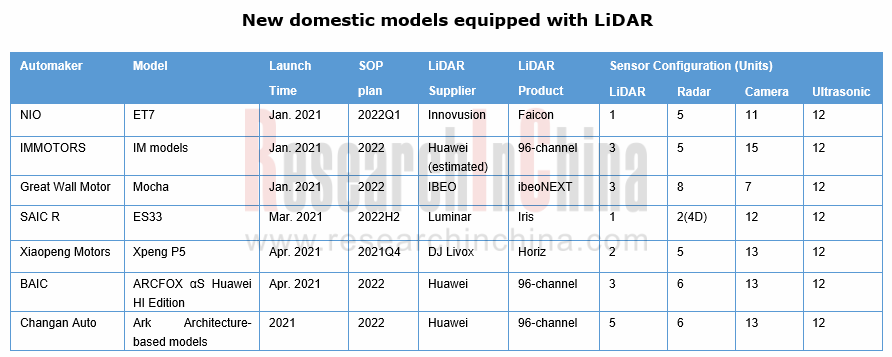
On April 14, Xpeng's third mass production car, the P5, was launched. The biggest highlight is that it is equipped with two DJI Livox LiDARs, which can realize the NGP function on urban roads. Following NIO ET7, Great Wall Mocha, IM and SAIC ES33, P5 is another new model equipped with LiDAR.
On April 17, the ARCFOX Alpha S Huawei HI equipped with three Huawei’s 96-channel LiDARs (installed on the center and both sides of the front) was officially unveiled; later, Changan’s model based on the Ark architecture will also be equipped with Huawei’s LiDAR.
The second model of Lixiang will also be equipped with LiDAR.
After years of development, automotive LiDAR technology roadmaps and products have been quite diversified. ResearchInChina has sorted out classification and composition of LiDAR, as shown in the figure below.
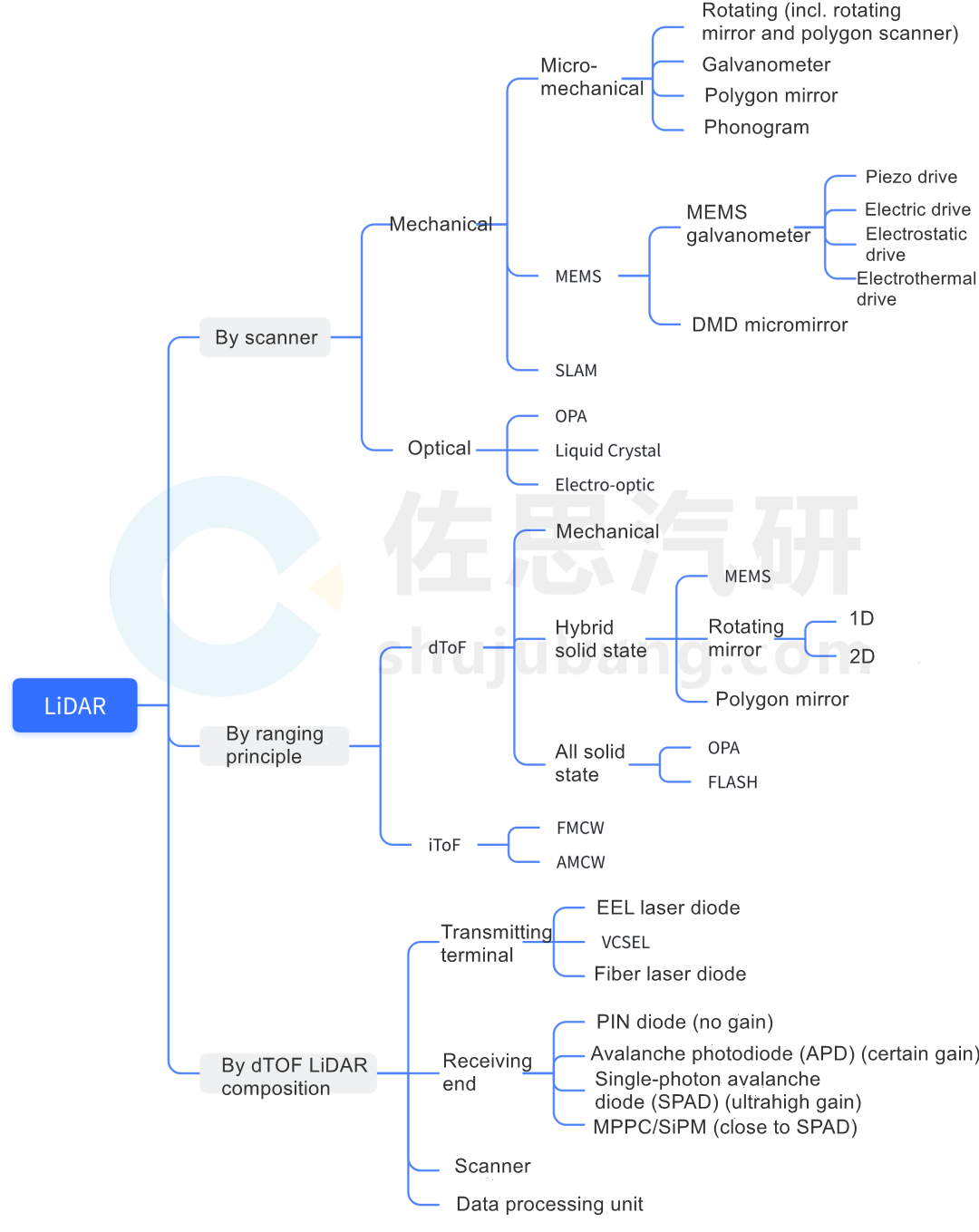
Early, LiDAR was mainly used in Robotaxi, Robotruck, Robobus, low-speed autonomous driving and roadside perception, etc. in small scale. The extensive application of LiDAR depends on the passenger car market.
As L4 technical solutions are gradually applied to L2-L3 models, LiDAR has been installed widely. LiDAR is currently available on production cars, and is mainly used to enhance ADAS functions and make new cars more appealing.
So far, domestic OEMs prefer to adopt hybrid solid-state LiDAR (including rotating mirror, prism, MEMS) solutions, mainly because:
First, it is easier to reduce the costs of hybrid solid-state LiDAR than mechanical LiDAR. Compared with pure solid-state (OPA, Flash) LiDAR, hybrid solid-state LiDAR technology is relatively mature and easier to commercialize.
Second, the Rotating Mirror Solution (represented by Valeo) is the first technical solution that meets National Automotive Standards and the performance requirements of automakers, and can be supplied in batches with controllable costs.
Xpeng P5 is equipped with two LiDARs (installed on both sides of the front bumper) from DJI Livox Horiz (customized version), which use the dual prism scanning solution, with the maximum detection distance of 150m (@10% reflectivity), the lateral field of view of 120 degrees, the angular resolution of 0.16°*0.2°, and the point cloud density equivalent to 144-channel LiDAR.
Xpeng Livox LiDAR uses 905nm wavelength at the transmitting side, APD at the receiving side, and double prism at the scanning side, namely Risley prism universal pointing system, with a unique non-repetitive scanning method.
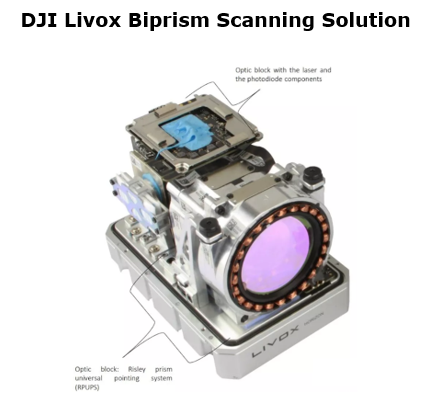
ARCFOX Alpha S Huawei HI is the first model equipped with Huawei’s three 96-channel LiDARs on the center and both sides of the front. Released in December 2020, the LiDAR has the maximum detection distance of 150m (@10% reflectivity), the field of view of 120°×25°, and the resolution of 0.25°×0.26°.
Combined with other sensors (6 radars, and 13 cameras and 12 ultrasonic radars), the LiDARs can achieve 360° coverage.
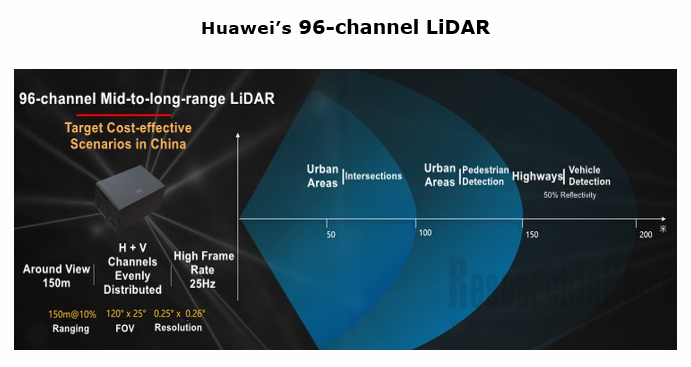
Huawei deploys long, medium and short-range LiDARs with a rotating mirror scanning architecture. Like Valeo Scala 1, Scala 2, the LiDARs comply with National Automotive Standards and are available on cars.
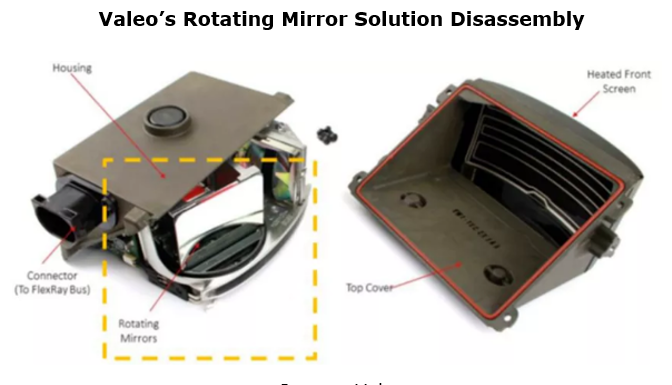
In addition to Huawei and Valeo, Innovusion and Luminar adopt similar technical solutions which however exploit two-axis rotating mirror scanning. They will soon conduct mass production for NIO ET7 and SAIC R ES33.
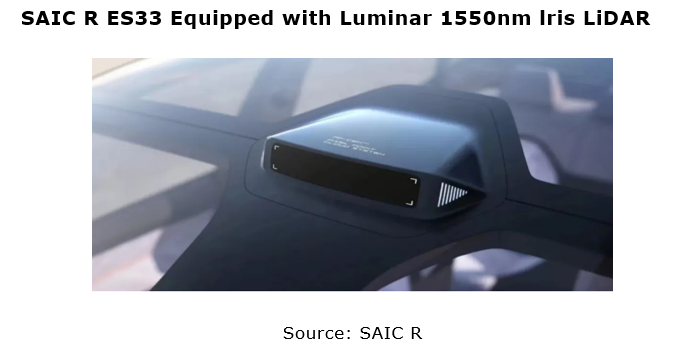
Luminar LiDAR features unique technical advantages: 1550nm wavelength (mainstream: 905nm) at the transmitting side, the low-cost InGaAs detector at the receiving side, self-made fourth-generation custom ASIC chips, and a 2D rotating mirror scanning method.

Luminar's Iris LiDAR based on this architecture has a detection distance of up to 250m (@5% reflectivity), and can detect dark objects on the road beyond 250m, with the resolution of up to 300PPD and the angular resolution of 120°×30°. At the same time, it has low costs. The price of IRIS for L2 advanced assisted driving is US$500; for L4/L5autonomous driving, it is less than US$1,000.
Innovusion and Luminar are alike in technology path. Both use 1550nm wavelength, fiber laser, and dual-axis rotating mirror scanning solution.
In January 2021, NIO ET7 was released, equipped with Innovusion's Falcon LiDAR. It will be mass-produced in 2022Q1.

In addition, RoboSense's MEMS LiDAR --- RS-LiDAR-M1 will soon be carried on Lucid Air. RoboSense released the RS-LiDAR-M1 SOP in January 2021, and will start mass production and delivery of the designated project in 2021Q2.
This product adopts RoboSense’s patented MEMS technology, with the farthest detection distance of 200m (150m@10%), the field of view of 120°×25°, and the resolution of 0.2°x0.2°.
In addition to RoboSense, players using MEMS technical solution include Innoviz, AEye, Pioneer, HESAI, Leishen Intelligent Systems, Zvision, etc. The third-generation product of Valeo’s is also based on MEMS technology.
Innoviz's InnovizOne will be installed on the new BMW iX in 2021; Valeo MEMS is expected to see mass production around 2022.
Main MEMS LiDAR Vendors and Their Typical Products

Source: ResearchInChina
Autonomous Driving Domain Controller and Central Computing Unit (CCU) Industry Report, 2025
Research on Autonomous Driving Domain Controllers: Monthly Penetration Rate Exceeded 30% for the First Time, and 700T+ Ultrahigh-compute Domain Controller Products Are Rapidly Installed in Vehicles
L...
China Automotive Lighting and Ambient Lighting System Research Report, 2025
Automotive Lighting System Research: In 2025H1, Autonomous Driving System (ADS) Marker Lamps Saw an 11-Fold Year-on-Year Growth and the Installation Rate of Automotive LED Lighting Approached 90...
Ecological Domain and Automotive Hardware Expansion Research Report, 2025
ResearchInChina has released the Ecological Domain and Automotive Hardware Expansion Research Report, 2025, which delves into the application of various automotive extended hardware, supplier ecologic...
Automotive Seating Innovation Technology Trend Research Report, 2025
Automotive Seating Research: With Popularization of Comfort Functions, How to Properly "Stack Functions" for Seating?
This report studies the status quo of seating technologies and functions in aspe...
Research Report on Chinese Suppliers’ Overseas Layout of Intelligent Driving, 2025
Research on Overseas Layout of Intelligent Driving: There Are Multiple Challenges in Overseas Layout, and Light-Asset Cooperation with Foreign Suppliers Emerges as the Optimal Solution at Present
20...
High-Voltage Power Supply in New Energy Vehicle (BMS, BDU, Relay, Integrated Battery Box) Research Report, 2025
The high-voltage power supply system is a core component of new energy vehicles. The battery pack serves as the central energy source, with the capacity of power battery affecting the vehicle's range,...
Automotive Radio Frequency System-on-Chip (RF SoC) and Module Research Report, 2025
Automotive RF SoC Research: The Pace of Introducing "Nerve Endings" such as UWB, NTN Satellite Communication, NearLink, and WIFI into Intelligent Vehicles Quickens
RF SoC (Radio Frequency Syst...
Automotive Power Management ICs and Signal Chain Chips Industry Research Report, 2025
Analog chips are used to process continuous analog signals from the natural world, such as light, sound, electricity/magnetism, position/speed/acceleration, and temperature. They are mainly composed o...
Global and China Electronic Rearview Mirror Industry Report, 2025
Based on the installation location, electronic rearview mirrors can be divided into electronic interior rearview mirrors (i.e., streaming media rearview mirrors) and electronic exterior rearview mirro...
Intelligent Cockpit Tier 1 Supplier Research Report, 2025 (Chinese Companies)
Intelligent Cockpit Tier1 Suppliers Research: Emerging AI Cockpit Products Fuel Layout of Full-Scenario Cockpit Ecosystem
This report mainly analyzes the current layout, innovative products, and deve...
Next-generation Central and Zonal Communication Network Topology and Chip Industry Research Report, 2025
The automotive E/E architecture is evolving towards a "central computing + zonal control" architecture, where the central computing platform is responsible for high-computing-power tasks, and zonal co...
Vehicle-road-cloud Integration and C-V2X Industry Research Report, 2025
Vehicle-side C-V2X Application Scenarios: Transition from R16 to R17, Providing a Communication Base for High-level Autonomous Driving, with the C-V2X On-board Explosion Period Approaching
In 2024, t...
Intelligent Cockpit Patent Analysis Report, 2025
Patent Trend: Three Major Directions of Intelligent Cockpits in 2025
This report explores the development trends of cutting-edge intelligent cockpits from the perspective of patents. The research sco...
Smart Car Information Security (Cybersecurity and Data Security) Research Report, 2025
Research on Automotive Information Security: AI Fusion Intelligent Protection and Ecological Collaboration Ensure Cybersecurity and Data Security
At present, what are the security risks faced by inte...
New Energy Vehicle 800-1000V High-Voltage Architecture and Supply Chain Research Report, 2025
Research on 800-1000V Architecture: to be installed in over 7 million vehicles in 2030, marking the arrival of the era of full-domain high voltage and megawatt supercharging.
In 2025, the 800-1000V h...
Foreign Tier 1 ADAS Suppliers Industry Research Report 2025
Research on Overseas Tier 1 ADAS Suppliers: Three Paths for Foreign Enterprises to Transfer to NOA
Foreign Tier 1 ADAS suppliers are obviously lagging behind in the field of NOA.
In 2024, Aptiv (2.6...
VLA Large Model Applications in Automotive and Robotics Research Report, 2025
ResearchInChina releases "VLA Large Model Applications in Automotive and Robotics Research Report, 2025": The report summarizes and analyzes the technical origin, development stages, application cases...
OEMs’ Next-generation In-vehicle Infotainment (IVI) System Trends Report, 2025
ResearchInChina releases the "OEMs’ Next-generation In-vehicle Infotainment (IVI) System Trends Report, 2025", which sorts out iterative development context of mainstream automakers in terms of infota...